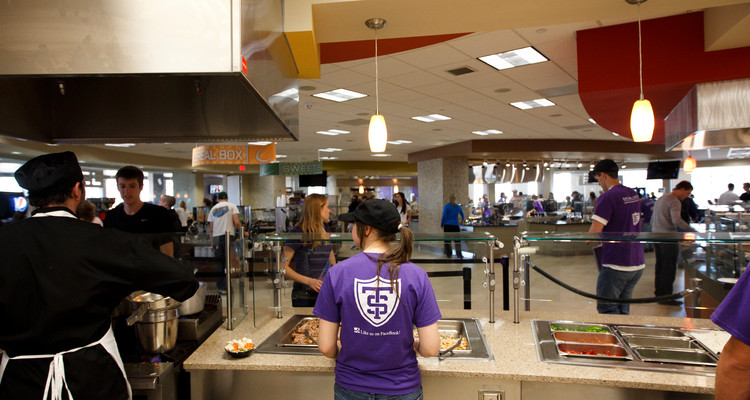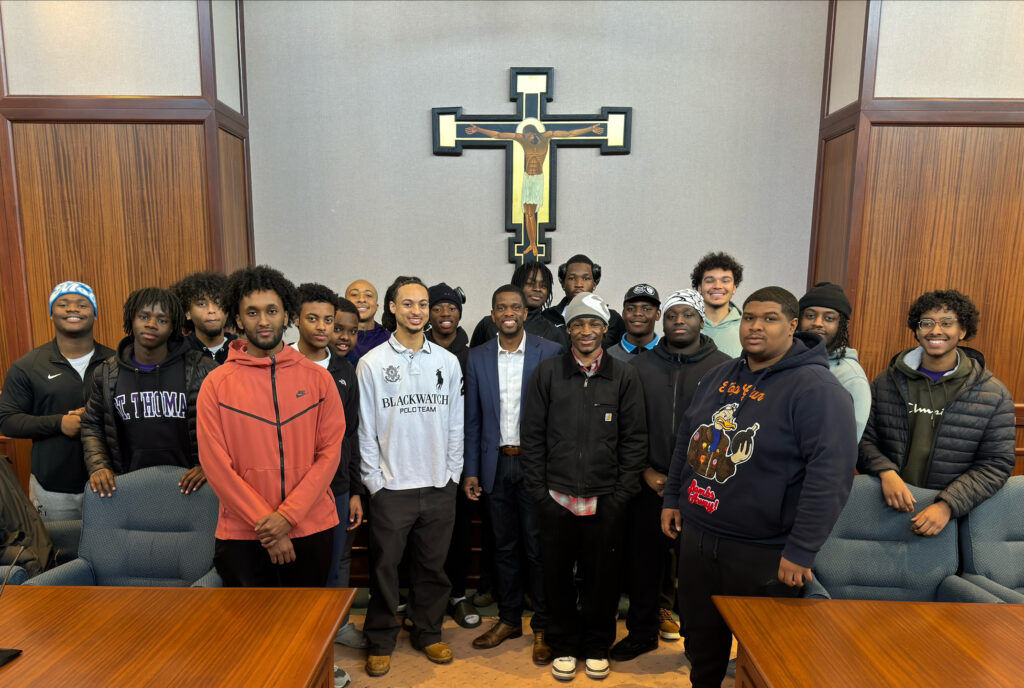Lauren Lundstrom started working at Summit Marketplace in the Anderson Student Center as a freshman for just an hour a week. She wanted to develop some time-management skills by having a consistent work commitment. Like many student workers, the desire to make money and the convenience of an on-campus gig drew her to apply.
Now, as a junior, Lundstrom works at Summit Marketplace pretty much every day. She likes the friendly atmosphere, talking with her co-workers and people when they come in, and getting to choose what music goes out over the store’s speakers.
“Working here is kind of a win-win: You get money, you build relationships, you get close with the intersection of the school, and it’s right here for you, really convenient. It’s nice,” she said.
Lundstrom is just one of the 3,000-4,000 students St. Thomas employs part time on an annual basis, a massive workforce that contributes to practically every aspect of the university, from resident advisers to landscape crews, to office workers across the university to servers at The View.
Jobs, jobs everywhere
An online stop at the university’s student employment opportunities page gives a sense of the variety of jobs students have available to them on campus throughout the year. Every one of the thousands of jobs falls into one of five categories for compensation: Undergraduate positions range from minimum wage – $9 an hour – up to $13 for non-technical positions, and $9-$15 an hour for technical positions; graduate employees can make anywhere from $11.50-$18 an hour; and law school students can make either $11 or $14 an hour. (St. Thomas’ minimum wage positions will follow the state's increase to $9.50 in July 2016.)
Every department in the university pulls from its own budget to compensate students. St. Thomas diverges from many universities in that students can be hired regardless of whether they qualify for a government-subsidized work study program, and they are compensated from each departmental budget the same. The only difference is that "at the university accounting level, St. Thomas will only pay approximately 25 percent of the students earnings and the government source will pay the balance of the earnings," said James Hammar, assistant director of admissions and financial aid.
“We want students to apply, and then different hiring departments make decisions to hire, and we want to make sure they’re hiring the best candidate,” St. Thomas student employment specialist Mary Ruce said. “They’re welcome to take the work study into account when they’re making those decisions as well.”
Working and learning
Every department can apply to have a new student job and there is no cap on the number of students they can hire (if the jobs are reasonable and if the money is there, said Terri Sheehan of the Human Resources Department). Allowing each department ownership over its position development results in the wide range of jobs students can apply for across the university; some positions are more technical and akin to professional internships, such as the graphic design positions Sara Klomp hires for in University Relations.
“In the end I’d like them to be able to graduate from here and have the equivalent of one to two years’ experience,” Klomp said. “When they go out they’re not another just college graduate trying to get their first job. They’ve got projects they’ve taken from start to finish, they know how to work with marketing people, they know systems.”
Each job strikes its own balance in the terms of “work study” too; some, like junior Jessica Eppenberger and freshman Kierstin Anderson, who work the front desk at McCarthy Gym, have the opportunity to do homework on the job when there’s downtime. Other students, like the approximately 450 who work for Dining Services, the university’s single largest unit for student employment, are working the vast majority of time they’re on the clock.
Dining Services stands as a strong example of the need for student workers: The university’s restaurants and catering services simply couldn’t run without them.
“It’s about a 60-40 mix, with 60 percent of our workforce as students,” said Todd Empanger, director of Dining Services. “We’re running a well-run machine, a business here. It’s no different than a business just down the street. It happens to be at a university, but there’s good food coming out of here. That’s what we want to maintain, and we need students to do it.”
Beyond service positions, Empanger said Dining Services hires students who help with marketing and menu development. Every student worker has the chance to learn different skills, no matter what they’re doing.
“It’s teaching moments for us. We look at ourselves as educational faculty of our own,” Empanger said. “We’re teaching them trade, showing them what they can do.”
The adage of “you get out what you put in” certainly applies to the part-time work students do across the university. Many students learn what's required of a good employee, which is alike in at least one aspect for every job at St. Thomas: You’ve got to show up and be ready to work.
“They learn that accountability,” said John Tschida, St. Thomas’ softball coach who also supervises McCarthy Gym. “It’s more flexible because it’s an educational setting. If they don’t show up and they’ve got excuses, in a normal job you’re just fired. We’ll try to work with you. There’s a bit of that educational process.”
Flexibility is a big part of what has kept senior Kristen Flaherty working at Tommie Central in the Anderson Student Center the past three years.
“The hours are really flexible and it’s easy to get shifts covered and moved around if you need to,” she said. “Working on campus, most employers believe you’re here for school first, so when school things come up there’s a little more leeway.”
Putting money directly toward tuition is an option many student take advantage of, while others, such as Lundstrom, use it outside of class.
“[My pay] doesn’t go to my tuition directly, but that’s a cool opportunity that St. Thomas has to do that,” she said. “I use it for more personal spending. Anything from transportation to activities on the weekend, I’ve found it necessary to have some inflow.”
Preparing for the future
Beyond getting paid at jobs that are conveniently on campus and put their educational priorities first, student workers at St. Thomas benefit from being more engaged with the university. Ruce, who was hired last year as part of the university’s effort to increase the value and efficiency of student work on campus, said student employment increases retention and helps develop stronger students. Flaherty has felt that in her time at Tommie Central.
“It’s fun with the job at Tommie Central because we get to know everything [about St. Thomas]. Or if we don’t know it we know how to find it,” she said. “That’s an aspect I like: being able to know what’s going on around campus. It has helped make me part of the St. Thomas community more.”
Like Klomp pointed out, many supervisors and student workers are conscious of the value their work has in prepping them for future jobs too. Strong recommendations and proof of good work over several years can be invaluable for seeking employment after graduation, whether at an outside company or eventually back at St. Thomas.
“I’ve helped several of them get jobs, and people who have hired them mention [their strong professional preparation] to me,” Klomp said. “I’ve hired back three [former student workers] when we’ve had full-time openings. … When they do come back they’re fabulous. They understand the system, the culture, the complications of working at a university. That’s been wonderful.”
Students making a full circle back to St. Thomas for employment is a common phenomenon: Between 2004 and 2010, 390 St. Thomas graduates (undergraduate and graduate) were hired and working at St. Thomas, making the university the second-largest employer of Tommies over that period behind Target (521). Many alumni, such as 2011 graduate Brian Woitte, returned to the same department they worked in as a student.
(Disclosure: I returned to University Relations as a full-time employee in 2014 after having worked there as a student from 2009-11.)
“It was a place that I always wanted to come back and work at. When I heard about this position it was definitely a job I wanted,” said Woitte, who returned last year to work in Campus Scheduling. “Especially with my experience and knowing campus, it was mainly the atmosphere and knowing what the university is like [that brought me to apply for a full time position]. It had a special meaning to me to come back and work for the place that helped me for four years become the person I am now.”
“Having students intern at your company is a great way for both sides to get their feet wet and check each other out. It ends up being the perfect employment pipeline,” Ruce added. “What a great opportunity. You have students who understand the culture here and can offer an insider view of things, what the student experience is like. They’re a great resource.”
Whether students end up returning after graduation to St. Thomas or not, the experience and financial support they receive while they are here is something thousands enjoy every year.
“It’s a win-win situation,” Sheehan said. “The university gets this great workforce and in turn, the workforce gets the experience and the pay to go along with it to help augment not only their financial needs, but their learning experience.”







